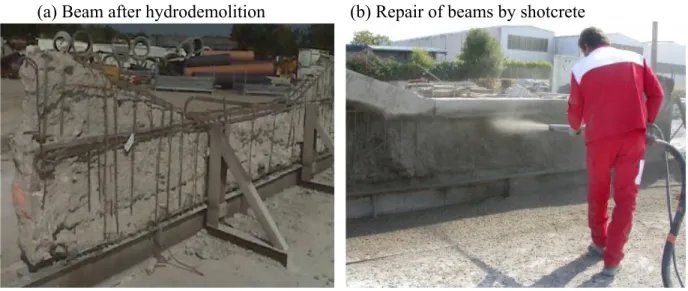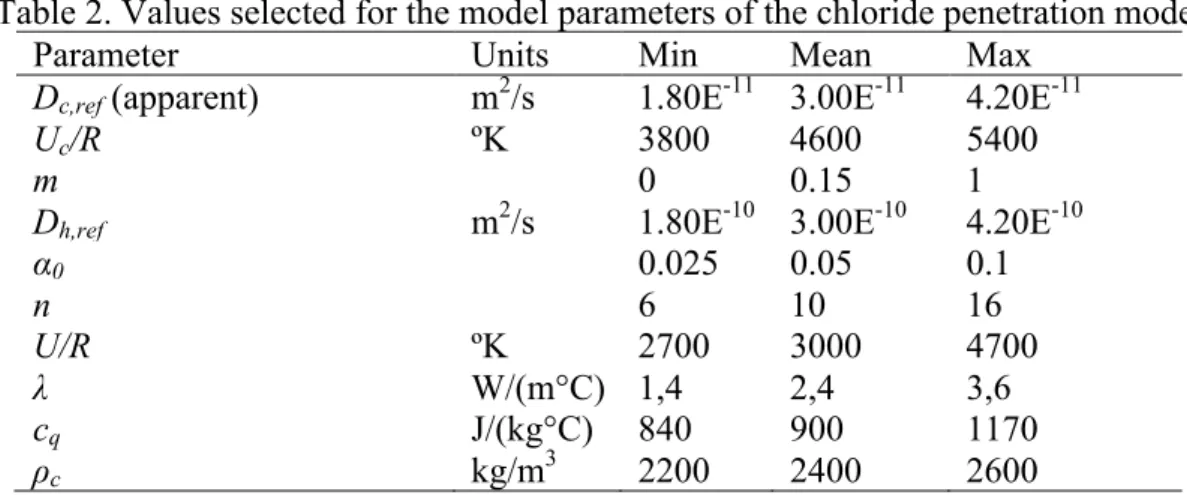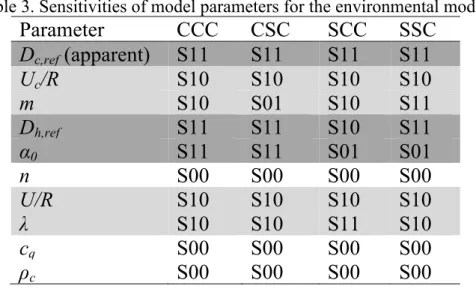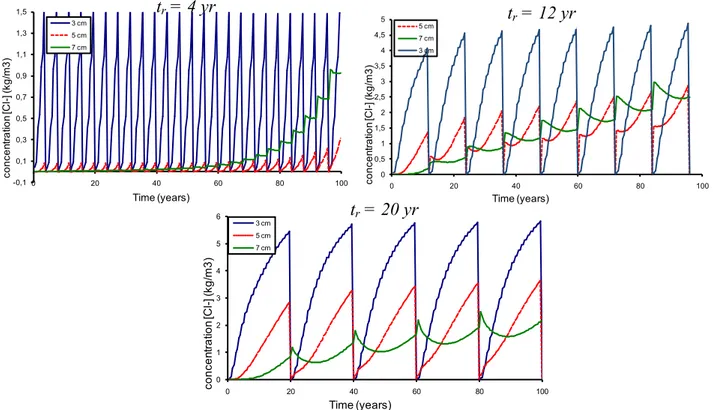HAL Id: hal-01008827
https://hal.archives-ouvertes.fr/hal-01008827
Submitted on 22 Sep 2020
HAL is a multi-disciplinary open access
archive for the deposit and dissemination of sci-entific research documents, whether they are pub-lished or not. The documents may come from teaching and research institutions in France or abroad, or from public or private research centers.
L’archive ouverte pluridisciplinaire HAL, est destinée au dépôt et à la diffusion de documents scientifiques de niveau recherche, publiés ou non, émanant des établissements d’enseignement et de recherche français ou étrangers, des laboratoires publics ou privés.
Distributed under a Creative Commons Attribution| 4.0 International License
Repair of concrete structures in marine environment:
optimization of concrete removing and cover
Emilio Bastidas-Arteaga, Franck Schoefs, Bruno Capra
To cite this version:
Emilio Bastidas-Arteaga, Franck Schoefs, Bruno Capra. Repair of concrete structures in marine environment: optimization of concrete removing and cover. Structural Faults & Repair 2010, 2010, Edinburgh, United Kingdom. �hal-01008827�
REPAIR OF CONCRETE STRUCTURES IN MARINE ENVIRONMENT:
OPTIMIZATION OF CONCRETE REMOVING AND COVER
F. Schoefs & E. Bastidas-Arteaga GeM, UMR 6183
University of Nantes, Centrale Nantes 2, rue de la Houssinière BP 92208 44322 Nantes Cedex 3 France emilio.bastidas@gmail.com B. Capra Société Oxand
36 bis avenue Franklin Roosevelt, 77210 Avon/Fontainebleau
France
KEYWORDS: maintenance, chloride penetration, sensitivity analysis, repair. ABSTRACT
The first part of this paper presents a sensitivity analysis of a comprehensive chloride ingress model. The sensitivity study is used to identify the more influencing environmental and model parameters. In a second part, the model of chloride ingress is adapted to model maintenance by cover rebuilding. This model allows us to study the effect of three parameters: quality of the repair material, repair depth and repair interval. From this study, it is concluded that there are optimum values that minimize both material costs and environmental impact.
INTRODUCTION
For reinforced concrete (RC) structures, corrosion induced by chloride ingress generates important damage after 10 or 20 years of service (Rosquoët et al., 2006, Bonnet et al., 2007). Consequently, its inspection and maintenance are essential to ensure an optimal level of serviceability and safety during its lifespan. It is shown over the word that maintaining safety requirements increases agency costs. Therefore, the main objective of this paper is to determine the parameters to be taken into account for increasing the effectiveness of repair by “cover rebuilding”.
Recently only few studies (Bastidas-Arteaga et al., 2010a and 2010b) provide comprehensive models for modeling chloride ingress under realistic conditions. Section 2 presents the basic principles of this model. Due to the complex phenomena involved in chloride ingress, several parameters should be quantified. A deterministic sensitivity analysis of the parameters influencing chloride ingress is presented in Section 3. Section 4 focuses on the effect of the parameters influencing the effectiveness of “cover rebuilding”. DESCRIPTION OF THE REPAIR TECHNIQUE AND THE CHLORIDE INGRESS MODEL Cover rebuilding
The requirements for this technique were defined within the framework of the MAREO1 project with the
collaboration of public agencies, construction companies and research institutions. In the strategy of maintenance considered herein, “cover rebuilding”, repair is undertaken by rebuilding the chloride-polluted concrete cover by several techniques (wet shotcrete, dry shotcrete, formed concrete and manual repair, Figure 1). Cover rebuilding is applicable to large-scale repair projects and is currently being tested on real RC structures at the Atlantic Port of Nantes St Nazaire.
1Maintenance and REpair of concrete coastal structures: risk-based Optimization (MAREO) Project
Please cite this paper as: Bastidas-Arteaga E., Schoefs F., Capra B., "Repair of concrete structures in marine environment: optimization of concrete removing and cover", Proceeding of Structural Faults & Repair2010 - Incorporating Early Age Construction + Materials Testing/ “Extending the Life of Bridges; Concrete + Composites, Buildings, Masonry + Civil Structures”, SFR 2010, Session Concrete Repair - 1, 7 pages, 15-17 June 2010, Edinburgh, Scotland, UK (2010).
(a) Beam after hydrodemolition (b) Repair of beams by shotcrete
Figure 1. Description of the repair procedure Chloride ingress model
Chloride ingress into concrete is controlled by a complex interaction between physical and chemical mechanisms that have often been modeled as a diffusion phenomenon in saturated media (Fick’s second law) (Tuutti, 1982). To properly model this phenomenon, it is implemented a comprehensive model that considers the interaction between: (i) chloride penetration, (ii) diffusion of moisture and (iii) heat transfer (Bastidas-Arteaga et al., 2010b). The coupled phenomenon is described by a set of partial differential equations that is solved by combining finite element and finite difference methods. The description of the formulation of the model is beyond the scope of this paper. We used here a one-dimensional model (semi-infinite domain). According to Bastidas-Arteaga et al, (2010b), this phenomenon is mainly governed by environmental and model parameters.
SENSITIVITY ANALYSIS OF THE CHLORIDE PENETRATION MODEL
Table 1 presents the parameters that should be quantified for modeling chloride penetration. In reliability analysis, their distribution and correlations should also be provided. This point should be considered with care when using analytical, empirical or semi-empirical relationships that have been developed by researchers looking for a good representation of average trends. Even if they have good asymptotic properties, their sensitivity to random inputs should be analyzed and submitted to expert judgment. This section studies the influence of these parameters.
Table 1. Parameters of the chloride penetration model
Phenomena Parameter Symbol Units
Chloride Reference chloride diffusion coefficient (apparent) Dc,ref m2/s
ingress Activation energy of the chloride diffusion process Uc kJ/mol
Aging factor m
Humidity Reference humidity diffusion coefficient Dh,ref m2/s
diffusion Parameter representing the ratio Dh,min/Dh,max α0
Parameter characterizing the spread of the drop in n
Activation energy of the chloride diffusion process U kJ/mol
Heat Thermal conductivity of concrete λ W/(m°C)
transfer Specific heat capacity of concrete cq J/(kg°C)
Sensitivity to environmental actions
In the following the environmental chloride concentration is constant and equals 6 kg/m3. We consider
two assumptions for modelling humidity h and temperature T as functions of time. In the former, h and T
are constant with time –i.e., Tmean=12.5 ºC and hmean=0.75. In the latter, h and T are cyclic and modelled
by a sinusoidal function that varies with time (one year periodic) with: Tmin=-5 ºC, Tmax=30 ºC, hmin= 0.6
and hmax= 0.9. To analyze the effect of temperature and humidity, we study the following situations:
– CCC: the input models are constant for temperature, humidity and environmental chloride concentration.
– SCC: the input models are sinusoidal for temperature and constant for humidity and environmental chloride concentration.
– CSC: the input models are constant for temperature and environmental chloride concentration and sinusoidal for humidity.
– SSC: the input models are sinusoidal for humidity and temperature and constant for environmental chloride concentration.
Figure 2 presents the chloride profiles after 38 years of exposure for the above mentioned cases. It appears clearly that the most critical case is SSC when both temperature and humidity are time-variant. Note that when humidity is constant (cases CCC and SCC) only diffusion occurs and the profiles are very similar whatever temperature model.
Figure 2. Profiles of chlorides after 38 years Sensitivity to the model parameters
Table 2 presents the representative values (minimum, mean and maximum) selected for this analysis. Each sensitivity analysis is performed independently. It means that when we study the sensitivity of one parameter the other 9 parameters are fixed at its mean values. Moreover, the four environmental assumptions described in section 3.1 as well as three concrete covers: 30, 50 and 70 mm, are considered. Consequently, 360 cases for a time-window of 100 years have been computed and studied.
Table 2. Values selected for the model parameters of the chloride penetration model
Parameter Units Min Mean Max
Dc,ref (apparent) m2/s 1.80E-11 3.00E-11 4.20E-11
Uc/R ºK 3800 4600 5400
m 0 0.15 1
Dh,ref m2/s 1.80E-10 3.00E-10 4.20E-10
α0 0.025 0.05 0.1 n 6 10 16 U/R ºK 2700 3000 4700 λ W/(m°C) 1,4 2,4 3,6 cq J/(kg°C) 840 900 1170 ρc kg/m3 2200 2400 2600
SSC
CSC
SCC
CCC
Table 3 presents the most relevant results of this sensitivity study according to the following the classification:
– S00: low sensitivity with time and depth.
– S01: low sensitivity with time but significant sensitivity with depth. – S10: significant sensitivity with time but low sensitivity with depth. – S11: significant sensitivity with time and depth.
Based on this classification, dark grey cells indicate the most influent parameters, clear grey cells show the parameters with medium influence and white cells the parameters with low influence. It is shown that chloride ingress is very sensitive to chloride and humidity diffusion coefficients.
Table 3. Sensitivities of model parameters for the environmental models
Parameter
CCC CSC SCC SSC
D
c,ref(apparent) S11
S11
S11
S11
U
c/R
S10
S10
S10
S10
m
S10
S01
S10
S11
D
h,refS11
S11
S10
S11
α
0S11
S11
S01
S01
n
S00
S00
S00
S00
U/R
S10
S10
S10
S10
λ
S10
S10
S11
S10
c
qS00
S00
S00
S00
ρ
cS00
S00
S00
S00
SIMULATION OF MAINTENANCESince testing the performance of the repair technique under several conditions is expensive and time-consuming, we adapted the numerical model of chloride penetration presented in section 2 to simulate the effects of repair. Three factors are considered to study the effectiveness of the maintenance policy:
– quality of the repair material (Table 4);
– depth of repaired concrete, crem; and
– repair interval (time between two repairs).
These factors can be considered as parameters of optimization in future works. For this analysis we only consider the most realistic environmental condition SSC. The maintenance model provides the evolution
of the total chloride concentration (in kg/m3 of concrete) at several depths for each studied case. The total
critical chloride content Ccrit is computed by assuming that corrosion starts for a content of 0.5% of
cement mass. This value corresponds to the mean between French (0.4%) and Spanish (0.6%)
requirements. Thus, for a concrete containing 400 kg of cement per m3, Ccrit = 2kg/m3 of concrete.
Effect of quality of the repair material
The parameters defining the quality of the repair material (Table 4) were determined based on the values presented in Table 2. The results presented in Figure 3 concern a maintenance policy where repair is
carried out by removing 6 cm of chloride-contaminated concrete –i.e., crem = 6cm. The evolution of
chloride content at depths of 5 and 7 cm are presented herein. We can observe that, depending on the quality of the repair material, the factor between the chloride content after 100 years reaches 10. When
considering a critical chloride content of 2 kg/m3 at a cover thickness of 5 cm, the low quality material
needs probably a repair action every 4 years (not reasonable from cost point of view). In contrast, for high quality materials, repairs carried out every 25 years are probably sufficient.
Table 4. Material parameters for the considered qualities
Parameter Units High
quality Medium quality Low quality Dc,ref (apparent) m
2/s 1.80E-11 3.00E-11 4.20E-11
Uc /R ºK 5400 4600 3800
m 0.15 0.15 0.15
Dh,ref m2/s 1.80E-10 3.00E-10 4.20E-10
α0 0.025 0.05 0.1 n 16 10 6 U/R ºK 4700 3000 2700 λ W/(m°C) 3.6 2.4 1.4 cq J/(kg°C) 900 900 900 ρc kg/m3 2400 2400 2400 0 0,05 0,1 0,15 0,2 0,25 0,3 0,0 20,0 40,0 60,0 80,0 100,0 co n ce nt ra tio n [C l-] (k g /m 3 ) Time (years) 5 cm 7 cm 0 0,5 1 1,5 2 2,5 3 3,5 4 4,5 5 0 20 40 60 80 100 co n ce nt ra tio n [C l-] (k g /m 3 ) Time (years) 5 cm 7 cm
Figure 3. Effect of the quality of the repair material on the evolution of chloride with time Effect of repair depth
Since there are several cases to analyze, we focus here on the SSC case and the medium quality material.
Let us consider the effect of three depths: crem = 5, 6 and 7 cm and a repair interval of 12 years. Figure 4
presents the effect of depth of repaired concrete on the evolution of the chloride content at 3, 5 and 7 cm. It is shown in all the cases that the chloride content at 7 cm decreases immediately after repair and increases when the chloride ions ingress into the repaired concrete. It means that chloride content at this position moves into two directions inside the structure and towards the concrete surface. When
considering a critical chloride content of 2 kg/m3 at 5 cm and a life-cycle of 100 years, the removing of 6
cm seems to be optimal from economical and environmental point of view (reduction of waste and CO2
emissions). 0 0,5 1 1,5 2 2,5 3 3,5 4 4,5 5 0 20 40 60 80 100 co n ce nt ra tio n [C l-] (k g /m 3 ) Time (years) 5 cm 7 cm 3 cm 0 0,5 1 1,5 2 2,5 3 3,5 4 4,5 5 0 20 40 60 80 100 co n ce n tr at io n [ C l-] (kg /m 3 ) Time (years) 3 cm 5 cm 7 cm crem = 5 cm crem = 6 cm
0 0,5 1 1,5 2 2,5 3 3,5 4 4,5 5 0 20 40 60 80 100 co n ce nt ra tio n [C l-] (k g /m 3 ) Temps (années) 3 cm 5 cm 7 cm
Figure 4. Effect of crem on the chloride content
Effect of repair interval
In order to study the effect of the length of the repair interval, tr, we consider a medium quality material
and crem = 6 cm. Figure 5 illustrates the evolution of chloride content at 3, 5 and 7 cm for three repair
intervals. The overall behavior indicates that the chloride concentrations at 5 and 7 cm decrease for lower
tr. By taking a critical chloride content of 2 kg/m3 at 5 cm and a reference period of 100 years, it is
observed that a repair interval of about 12 years seems to be optimal. However, a comprehensive maintenance policy should consider time-variant repair intervals to optimize the management of resources and minimize the probability of corrosion initiation.
-0,1 0,1 0,3 0,5 0,7 0,9 1,1 1,3 1,5 0 20 40 60 80 100 co n ce nt ra tio n [C l-] (k g /m 3 ) Time (years) 3 cm 5 cm 7 cm 0 0,5 1 1,5 2 2,5 3 3,5 4 4,5 5 0 20 40 60 80 100 co n ce nt ra tio n [C l-] (k g /m 3 ) Time (years) 5 cm 7 cm 3 cm 0 1 2 3 4 5 6 0 20 40 60 80 100 co n ce nt ra tio n [C l-] (k g /m 3 ) Time (years) 3 cm 5 cm 7 cm
Figure 5. Impact of tr on the chloride content
CONCLUSIONS
The first part of this paper presented a sensitivity analysis of the chloride penetration model. This analysis showed that chloride ingress is highly influenced by the cyclic variation of temperature and humidity. After, we identified the most influencing parameters of the model. The second part illustrates the effects of the three parameters that control the effectiveness of cover rebuilding: quality of the repair material,
crem = 7 cm
tr = 4 yr tr = 12 yr
repair depth and repair interval. The results of this analysis show that there are optimum values of these parameters that minimize both material costs and environmental impact.
ACKNOWLEDGEMENTS
The authors acknowledge financial support of the MAREO project – contact:
franck.schoefs@univ-nantes.fr.
REFERENCES
Bastidas-Arteaga E., Schoefs F., Chateauneuf A., Sanchez-Silva M., Capra B., “Probabilistic evaluation of the sustainability of maintenance strategies for RC structures exposed to chloride ingress”, International Journal of Engineering Under Uncertainty: Hazards, Assessment and Mitigation (IJEUU:HAM), Special Issue, 2010a.
Bastidas-Arteaga E., Chateauneuf A., Sanchez-Silva M., Bressolette P. and Schoefs F. “A comprehensive probabilistic model of chloride ingress in unsaturated concrete”, Submitted to Engineering structures, 2010b.
Bonnet S., Schoefs F., Rosquoët F., Khelidj A., “Statistical study on total chloride profiles”, Proc. of the Fifth International Conference on Concrete under Severe Conditions Environment and Loading (CONSEC’07), Tours, France, June 4-6, 2007.
Rosquoët F., Bonnet S., Schoefs F., Khelidj A., “Chloride propagation in concrete harbour”. In: 2nd International RILEM Symposium on Advances in Concrete through Science and Engineering. Marchand, J. Bissonnette, B. Gagné, R. Jolin, M. and Paradis, Quebec, Canada, 2006.
Tuutti K., Corrosion of steel in concrete, Swedish Cement and Concrete Institute, 1982.
View publication stats View publication stats




